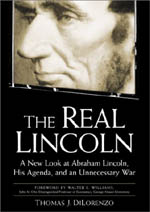 In secular America, the closest thing we have to a state religion is the Cult of Lincoln. To criticize our sixteenth president is, in some circles, the height of anti-Americanism.
In secular America, the closest thing we have to a state religion is the Cult of Lincoln. To criticize our sixteenth president is, in some circles, the height of anti-Americanism.
Mention Lincoln in an unflattering (i.e., truthful) way, and Alan Keyes, already a wide-eyed kook, practically froths at the mouth.
According to the orthodox theology, Lincoln is “Honest Abe,” the man who fulfilled the promise of the Declaration of Independence, the saint who saved the Union and freed the slaves. He is a martyr to freedom.
It is no wonder that Thomas J. DiLorenzo’s new book, “The Real Lincoln: A New Look at Abraham Lincoln, His Agenda and an Unnecessary War,” fell under attack even before it was published. DiLorenzo is an economist at Loyola College in Maryland, and like any good economist, DiLorenzo follows the money.
Lincoln’s ambivalence toward slavery is well documented. As most know, Lincoln said that if he could save the Union without freeing a single slave he would do so. So, DiLorenzo searches Lincoln’s speeches, looking for Lincoln’s real motive for refusing to let the South go its own way.
The trail leads to Lincoln’s political hero, Henry Clay, who envisioned what he called the “American System.”
The American System, the core of the Whig Party’s political agenda, was based on high protective tariffs, a centralized banking system and “internal improvements,” the last being what we now call “corporate welfare.”
Like most Republicans of his day, Lincoln began his career as a Whig, and he was an enthusiastic supporter of Clay’s program.
“When the Whig Party imploded in the mid-1850s, Lincoln switched to the Republican Party,” writes DiLorenzo, “but assured his Illinois constituents that there was no difference between the two.”
As a lawyer, Lincoln represented railroad companies, prime recipients of government support under the Whig program. Lincoln was, in modern terminology, a lobbyist.
When Lincoln finally attained the presidency, he was at last in a position to reward the interests that had backed his political career.
Unfortunately, such subsidies were an expensive proposition, especially for the small federal government of the day. Lincoln needed all of the tax revenue he could get, and Southern secession was a threat to that revenue stream.
“[B]y 1860 the Southern states were paying in excess of 80 percent of all tariffs,” writes DiLorenzo. And although Lincoln did enact the first (unconstitutional) income tax during the war, prior to the war, the tariff was virtually the only source of income for the federal government. Without the Southern ports that received most of the country’s imports, Lincoln could not possibly mount his campaign for a larger federal government, handing out subsidies to industrial interests.
But what of secession? If the South did not have the right to leave the Union, if the Confederate leaders were all traitors, then Lincoln’s motivations may not be relevant.
Unlike some apologists for the Confederacy, DiLorenzo does not fall into the trap of romanticizing the Old South or making excuses for slavery. The evil of slavery is unquestionable. For DiLorenzo, it is simply a matter of showing that the South had the right to secede, for good or ill.
With an array of sources, he demonstrates that the South did have the right to leave. Indeed, until Lincoln came along, the right of secession was something upheld in both the South and the North.
In the early 1800s, New England secessionists threatened to dissolve the Union over issues ranging from the Louisiana Purchase to the War of 1812.
But what of slavery? Wasn’t the war necessary to end its evil?
“Dozens of countries,” writes DiLorenzo, “including possessions of the British, French and Spanish empires, ended slavery peacefully during the late eighteenth and nineteenth centuries. Only in the United States was warfare associated with emancipation.” (Emphasis in the original.)
Violence on the level of slave uprisings (as in Haiti) did occur, but not warfare on the scale of the Civil War, which set the standard for total warfare, from which not even noncombatants are safe.
Terrorizing civilians (including slaves) was common practice for the Union army, DiLorenzo shows. He quotes Union Colonel John Beatty: “Every time the telegraph wire was cut we would burn a house; every time a train was fired upon we would hang a man; and we would continue to do this until every house was burned and every man hanged between Decatur and Bridgeport.”
Walk through the historic district of Decatur, Ala., and you will find it dominated by Victorian architecture. There is a reason for that.
 DiLorenzo makes a persuasive case that Lincoln’s heroic reputation is undeserved. Lincoln is the father of the centralized state, the architect of unrestricted warfare and the president who, more than any other, helped bring to an end the republic of the Founding Fathers.
DiLorenzo makes a persuasive case that Lincoln’s heroic reputation is undeserved. Lincoln is the father of the centralized state, the architect of unrestricted warfare and the president who, more than any other, helped bring to an end the republic of the Founding Fathers.




